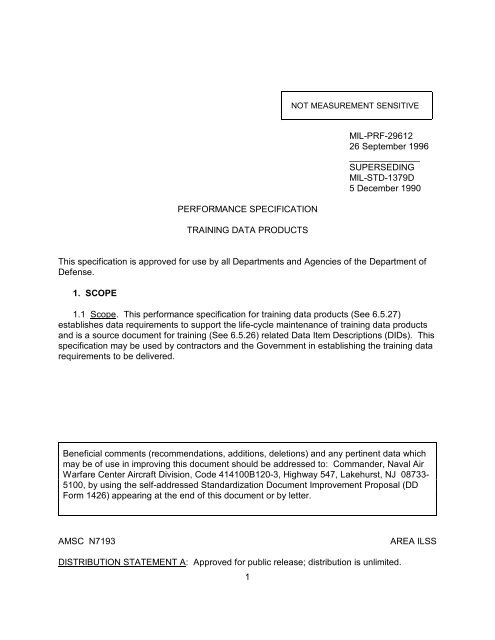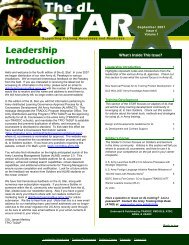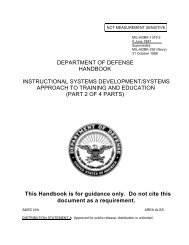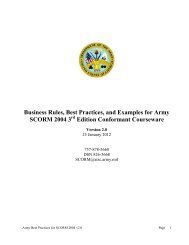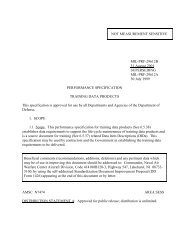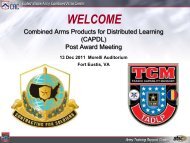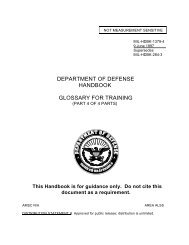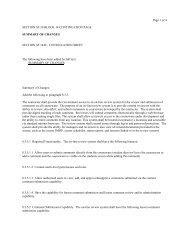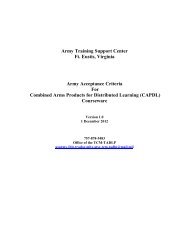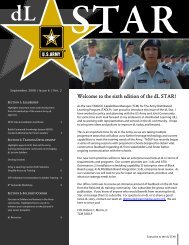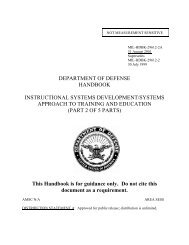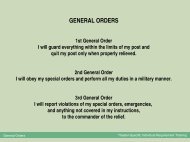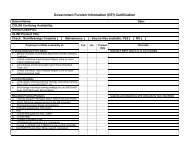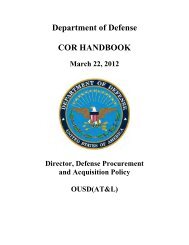MIL-PRF-29612 - U. S. Army Training Support Center
MIL-PRF-29612 - U. S. Army Training Support Center
MIL-PRF-29612 - U. S. Army Training Support Center
- No tags were found...
Create successful ePaper yourself
Turn your PDF publications into a flip-book with our unique Google optimized e-Paper software.
<strong>MIL</strong>-<strong>PRF</strong>-<strong>29612</strong>existing training needs and to survey training programs and technologies for applicability tonew training needs.3.2.2 Instructional performance requirements document. This training data product shallprovide specific personnel performance requirements data necessary to support the design ofa training program.3.2.3 Instructional media requirements document. This training data product shall providespecific requirements data necessary for the development of instructional media (See 6.5.8).3.2.4 Instructional media design package. This training data product shall provide specificrequirements data for documentation necessary for the development and production ofcourseware (See 6.5.5).3.2.5 <strong>Training</strong> program structure document. This training data product shall provideinformation necessary for the acquisition of resources for the conduct of training. It shall alsoprovide information necessary for training implementation management.3.2.6 Course conduct information package. This training data product shall provide datarequired by the Government for outsourcing (See 6.5.16) the conduct of training. This productshall provide sufficient information for an accurate evaluation of a student’s (See 6.5.22)capabilities to meet all objectives of a course (See 6.5.3) and shall identify prerequisite (See6.5.17) knowledge and skills (See 6.5.20) of students entering the course. This product shallinform students of the training syllabus, organization, operation, scheduling, and otherpertinent information. This product shall also provide information on an evaluation of atrainee’s (See 6.5.25) performance, the trainee evaluation of training, and shall provide thetrainee with a certificate of training.3.2.7 <strong>Training</strong> conduct support document. This training data product shall providedefinition and direction for instructors and trainees for the conduct of formal training. Thisproduct also supports the trainee’s mastery of knowledge, skills, and attitudes for a givensubject.3.2.8 <strong>Training</strong> evaluation document. This training data product shall provide specificrequirements data necessary to determine the effectiveness of training.3.2.9 Test package. This training data product shall provide specific requirements datanecessary for the examination of an individual’s knowledge, skills, attitudes, and achievementof learning objectives (See 6.5.11).3.2.10 Instructional media package. This training data product shall provide specific datanecessary to support the transfer of knowledge, skills, and attitudes by use of instructionalmedia.3.2.11 <strong>Training</strong> system support document. This training data product shall provide specificdata necessary for the operation and life-cycle software configuration management of atraining system.3
<strong>MIL</strong>-<strong>PRF</strong>-<strong>29612</strong>4. VERIFICATION4.1 Classifications of inspections. This specification provides two types of verification(Type A and Type B) which can be used for the verification of training data products.Acceptable evaluation criteria values shall be as specified in the contract. The inspectionrequirements specified herein are classified as follows:a. <strong>Training</strong> data product accuracy and completeness verification procedures (See 4.2.1).b. <strong>Training</strong> data product life-cycle maintenance verification procedures (See 4.2.2).4.2 <strong>Training</strong> data product accuracy verification. Verification Types A and B, listed below,shall be used to verify the accuracy, completeness, and life-cycle maintenance capability ofeach training data product as specified in the contract. Each verification type involves twosteps: 1) examine the product to determine the percentage of accuracy and, 2) evaluate theresults of the examination conducted in step one to determine that the evaluation criteriavalues specified in the contract are met. Examine and evaluate – these words are usedthroughout this section and are to be viewed as separate but related steps of the verificationprocess. The quantity of training data to be examined and the evaluation criteria values(stated as a percentage or as pass/fail) shall be as specified in the contract. Equipmenthazard, personnel safety, and environmental related data shall be examined for 100%accuracy. The evaluation will be a review of the examination results and a determination as towhether the training data product meets, exceeds, or fails to meet the evaluation criteria values(stated as a percentage or pass/fail) as stated in the contract. The Government maintains theright to re-examine data to ensure its integrity. Verification requirements and the criteria fordetermining performance are as follows:4.2.1 <strong>Training</strong> data product accuracy and completeness verification procedures (Type A).Examination and evaluation of the data contained in the training data product shall verifyaccuracy and completeness as follows:a. Step 1: Examinations shall confirm traceability of the training data to the mission anddesign parameters. Examinations shall determine a percentage of accuracy for thedata that was examined. The quantity of training data to be examined forcompleteness, scope of coverage, comprehensiveness, clarity, logical sequence,accuracy, and references shall be as specified in the contract.b. Step 2: Evaluations shall validate the integrity of the data. Evaluations shall determineif the results of the examination meet contract requirements. Results of theexaminations shall be evaluated during progress reviews, acceptance inspections,course trials (See 6.5.4), and small group trials (See 6.5.21) as specified in thecontract.4.2.2 <strong>Training</strong> data product life-cycle maintenance verification procedures (Type B).Examination and evaluation of the data contained in the training data product shall verify datalife-cycle maintenance capability (See 6.5.15) as follows:a. Step 1: Examinations shall confirm that an audit trail exists among the training dataproduct, other training data products, and the mission/system configuration.4
<strong>MIL</strong>-<strong>PRF</strong>-<strong>29612</strong>Examinations shall determine a percentage of accuracy for the data that wasexamined. The quantity of data to be examined for the existence of an audit trail shallbe as specified in the contract.b. Step 2: Evaluations shall validate the integrity of the audit trail. Evaluations shalldetermine if the results of the examination meet contract requirements. Results of theexaminations shall be evaluated during progress reviews, acceptance inspections,course trials, and small group trials, as specified in the contract.4.2.3 <strong>Training</strong> data product performance requirements/verification criteria cross-reference.Table I provides a cross-reference between the Section 3 performance requirementsparagraph and the corresponding Section 4 verification criteria paragraph for each trainingdata product.TABLE I. Performance requirements/verification criteria cross-reference.TRAINING DATA PRODUCT<strong>MIL</strong>-<strong>PRF</strong>-<strong>29612</strong>Section 3 paragraph<strong>MIL</strong>-<strong>PRF</strong>-<strong>29612</strong>Section 4 paragraph<strong>Training</strong> situation document 3.2.1 4.3.1Instructional performance requirements3.2.2 4.3.2documentInstructional media requirements document 3.2.3 4.3.3Instructional media design package 3.2.4 4.3.4<strong>Training</strong> program structure document 3.2.5 4.3.5Course conduct information package 3.2.6 4.3.6<strong>Training</strong> conduct support document 3.2.7 4.3.7<strong>Training</strong> evaluation document 3.2.8 4.3.8Test package 3.2.9 4.3.9Instructional media package 3.2.10 4.3.10<strong>Training</strong> system support document 3.2.11 4.3.114.3 Data product performance verification. Specific examination and evaluationrequirements for each of the training data products are as follows:4.3.1 <strong>Training</strong> situation document. The following verification procedures shall beperformed for the training situation document:4.3.1.1 <strong>Training</strong> situation document - Type A. Examinations and evaluations shall beperformed as follows:a. Examine the data that describes the existing training situation to determine that it issufficient to support the conduct of a situation analysis. Evaluate the data using apass/fail method.b. Examine the training situation analysis data to determine that the impact statementsprovide an accurate description of the specific resource deficiencies or excesses5
<strong>MIL</strong>-<strong>PRF</strong>-<strong>29612</strong>caused by the situation. Evaluate the level of accuracy determined during theexamination against the required percentage of accuracy as specified in the contract.c. Examine the training situation analysis data to determine that the recommendationssupport the most cost effective alternative. Evaluate the data using a pass/fail method.d. Examine the training technology assessment data to determine if similar systems thatwere analyzed had features applicable to the new training requirement. Evaluate thelevel of accuracy determined during the examination against the required percentage ofaccuracy as specified in the contract.e. Examine the training technology assessment data to determine if the simulation andinstructional features list provides the optimal mix of training equipment (See 6.5.28)required to support the training under study. Evaluate the level of accuracy determinedduring the examination against the required percentage of accuracy as specified in thecontract.4.3.2 Instructional performance requirements document. The following verificationprocedures shall be performed for the instructional performance requirements document:4.3.2.1 Instructional performance requirements document - Type A. Examinations andevaluations shall be performed as follows:a. Examine the document to determine whether training program design parameters aretraceable to specific program mission elements to be supported by the training.Evaluate the level of accuracy determined during the examination against the requiredpercentage of accuracy as specified in the contract.b. Examine the performance data concerning collective and individual task (See 6.5.24)statements, performance measures and levels, and affected occupational skill areas todetermine their relationship with personnel performance requirements. Evaluate thelevel of accuracy determined during the examination against the required percentage ofaccuracy as specified in the contract.c. Examine the learning objectives to determine that each describes the behavior,condition, and standard required to support the related task performance. Evaluate thelevel of accuracy determined during the examination against the required percentage ofaccuracy as specified in the contract.d. Examine the task descriptions to determine that each describes a single unit of specificwork behavior with clear beginning and ending points, and is directly observable orotherwise measurable. Evaluate the level of accuracy determined during theexamination against the required percentage of accuracy as specified in the contract.e. Examine the task difficulty level, conditions, and standards of the learning objectives,and the learning (See 6.5.9) difficulty required to identify student target population (See6.5.23) prerequisites to determine the data accuracy. Evaluate the level of accuracydetermined during the examination against the required percentage of accuracy asspecified in the contract.f. Examine the learning objectives data to determine if the learning objectives, learningtypes, instructional methodologies, learning hierarchies, and instructional settingsupports the minimum learning requirements for personnel performance. Evaluate thedata using a pass/fail method.6
<strong>MIL</strong>-<strong>PRF</strong>-<strong>29612</strong>g. Examine the training course mission, recommended course length, and class size datato determine the supportability of student throughput requirements. Evaluate the levelof accuracy determined during the examination against the required percentage ofaccuracy as specified in the contract.h. Examine the data concerning media to determine if learning objectives are supportedby the recommended materials. Evaluate the data using a pass/fail method.i. Examine the learning objectives hierarchies data and flow diagrams to determine thatthey will support the development of a cost effective course of instruction. Evaluate thedata using a pass/fail method.j. Examine the learning objectives data to ensure the strategy for combining, sequencing,and presenting learning objectives will support course development. Evaluate the levelof accuracy determined during the examination against the required percentage ofaccuracy as specified in the contract.k. Examine the learning objectives data to determine:(1) Traceability of the learning objective to the particular task that it supports.(2) Adequacy of the learning objectives for developing lesson (See 6.5.12)materials.Evaluate the level of accuracy determined during the examination against the requiredpercentage of accuracy as specified in the contract.l. Examine the Personnel Performance Profile (PPP) item number to determine if itreflects the correct knowledge and skill category. Evaluate the data using a pass/failmethod.4.3.2.2 Instructional performance requirements document - Type B. Examine the quantityof data relating to the audit trail among performance tasks, learning objectives, and media asspecified in the contract. Evaluate the results of the examinations during acceptanceinspections and course trials to verify data life-cycle maintenance capability as specified in thecontract. Evaluate the level of accuracy determined during the examination against therequired percentage of accuracy as specified in the contract.4.3.3 Instructional media requirements document. The following verification proceduresshall be performed for the instructional media requirements document:4.3.3.1 Instructional media requirements document - Type A. Examinations andevaluations shall be performed as follows:a. Examine the media selection model data to determine its capability to support theidentification of cost effective media for the specified training requirement. Evaluatethe data using a pass/fail method.b. Examine the instructional media requirements document to determine whether theinstructional media delivery system recommendations are traceable to specific missionelements. Evaluate the level of accuracy determined during the examination againstthe required percentage of accuracy as specified in the contract.7
<strong>MIL</strong>-<strong>PRF</strong>-<strong>29612</strong>c. Examine the cost effectiveness and alternative analysis study results to determine thatresults are accurately reflected in the recommendations for primary and alternateinstructional media delivery systems. Evaluate the data using a pass/fail method.d. Examine the data concerning alternatives to determine whether each alternativeconsidered will support the training requirement. Evaluate the data using a pass/failmethod.e. Examine the sensory stimulus (See 6.5.19) requirements to determine their accuracyfor supporting each of the specified learning objectives. Evaluate the level of accuracydetermined during the examination against the required percentage of accuracy asspecified in the contract.f. Examine the recommended instructional media delivery system data to determine thecapability to support the learning objective stimulus requirements. Evaluate the level ofaccuracy determined during the examination against the required percentage ofaccuracy as specified in the contract.g. Examine the instructional media delivery system functional characteristics data todetermine the traceability to the sensory stimulus requirement. Evaluate the level ofaccuracy determined during the examination against the required percentage ofaccuracy as specified in the contract.h. Examine the functional characteristics data to determine whether the characteristics arestated in performance terms. Evaluate the level of accuracy determined during theexamination against the required percentage of accuracy as specified in the contract.i. Examine the training system modification data to determine that all training deficienciesare satisfied. Evaluate the data using a pass/fail method.4.3.4 lnstructional media design package. The following verification procedures shall beperformed for the instructional media design package:4.3.4.1 lnstructional media design package - Type A. Examinations and evaluations shallbe performed as follows:a. Examine the summary description of the training program data to determine ifresources required to operate the instructional media package can be provided by theGovernment. Evaluate the data using a pass/fail method.b. Examine the courseware design strategy to determine that all critical elements havebeen addressed. Evaluate the data using a pass/fail method.c. Examine the lesson strategy to determine its ability to support the development oflessons. Evaluate the level of accuracy determined during the examination against therequired percentage of accuracy as specified in the contract.d. Examine the lesson strategy and resulting prototype lesson to determine if theprototype lesson conforms to the lesson format guide (See 6.5.13). Evaluate the levelof accuracy determined during the examination against the required percentage ofaccuracy as specified in the contract.e. Examine the lesson design strategies for traceability to the applicable learningobjective, and the scope of lesson strategies for appropriateness to the related tasklearning difficulty. Evaluate the level of accuracy determined during the examinationagainst the required percentage of accuracy as specified in the contract.8
<strong>MIL</strong>-<strong>PRF</strong>-<strong>29612</strong>f. Examine the lesson strategy for traceability to the courseware development process.Evaluate the level of accuracy determined during the examination against the requiredpercentage of accuracy as specified in the contract.g. Examine the remediation (See 6.5.18) and branching design criteria (See 6.5.2) todetermine whether they allow for differences in learning processes. Evaluate the levelof accuracy determined during the examination against the required percentage ofaccuracy as specified in the contract.h. Examine the performance tracking control features to ensure sufficient features areincluded to obtain all information necessary for student tracking and progress reporting.Evaluate the level of accuracy determined during the examination against the requiredpercentage of accuracy as specified in the contract.i. Examine the courseware logic flow diagrams (See 6.5.6) to determine that thediagrams contain sufficient data to support the development of courseware. Evaluatethe level of accuracy determined during the examination against the requiredpercentage of accuracy as specified in the contract.4.3.4.2 lnstructional media design package - Type B. Examine the quantity of datarelating to the audit trail among course strategy, lesson strategy, lesson content, tasks,learning objectives, and flow diagrams as specified in the contract. Evaluate the results of theexaminations during acceptance inspections and course trials to verify data life-cyclemaintenance capability as specified in the contract. Evaluate the level of accuracy determinedduring the examination against the required percentage of accuracy as specified in thecontract.4.3.5 <strong>Training</strong> program structure document. The following verification procedures shall beperformed for the training program structure document:4.3.5.1 <strong>Training</strong> program structure document - Type A. Examinations and evaluationsshall be performed as follows:a. Examine the training planning data to determine that the training needs and trainingstrategies support mission requirements by course, training program, and Servicecomponent for peacetime and mobilization. Evaluate the level of accuracy determinedduring the examination against the required percentage of accuracy as specified in thecontract.b. Examine the training planning data (including justification and impact) to determine thatit is traceable to mission needs and training requirements. Evaluate the level ofaccuracy determined during the examination against the required percentage ofaccuracy as specified in the contract.c. Examine training planning data concerning the milestone schedules to determinewhether proposed milestone schedules support the parent program schedules.Evaluate the data using a pass/fail method.d. Examine the training planning resource requirements and availability data to determinetraceability to course data and milestone schedules. Evaluate the level of accuracydetermined during the examination against the required percentage of accuracy asspecified in the contract.e. Examine the training course data to determine whether it will support management ofdevelopment and the conduct of training. Evaluate the level of accuracy determined9
<strong>MIL</strong>-<strong>PRF</strong>-<strong>29612</strong>during the examination against the required percentage of accuracy as specified in thecontract.4.3.5.2 <strong>Training</strong> program structure document - Type B. Examine the quantity of datarelating to the audit trail among mission needs, training requirements, course data, andresource requirements as specified in the contract. Evaluate the results of the examinationsduring acceptance inspections and course trials to verify data life-cycle maintenance capabilityas specified in the contract. Evaluate the level of accuracy determined during the examinationagainst the required percentage of accuracy as specified in the contract.4.3.6 Course conduct information package. The following verification procedures shall beperformed for the course conduct information package.4.3.6.1 Course conduct information package - Type A. Examinations and evaluationsshall be performed as follows:a. Examine the trainee orientation guidance data to determine that it contains allinformation required to introduce the student to all aspects of the training course. Thisincludes examination of data related to the organization conducting the training,student reporting, housing, messing, transportation, syllabus, course scheduling, andstudent record keeping. Evaluate the data using a pass/fail method.b. Examine the training course standards data to determine that student prerequisite skillshave been identified. Evaluate the data using a pass/fail method.c. Examine the training course standards data to determine that sufficient information isprovided to measure a graduate student’s capability to meet the terminal learningobjectives and enabling learning objectives. Evaluate the level of accuracy determinedduring the examination against the required percentage of accuracy as specified in thecontract.d. Examine training course standards data to determine that terminal learning objectivesand enabling learning objectives meet the training requirement. Evaluate the datausing a pass/fail method.e. Examine the trainee materials data (student handouts) to determine that all informationnecessary to support the student’s achievement of the terminal learning objectives andenabling learning objectives is included. The evaluation shall consist of a small grouptrial method as specified in the contract. Evaluate the data using a pass/fail method.f. Examine the trainee and training course completion data to determine that allrequirements were addressed. Evaluate the data using a pass/fail method.g. Examine the trainee and training course completion data to determine that theinstructor was properly prepared to conduct the course, that the time allocated andtraining method used for each lesson was satisfactory, and that each student achievedthe course objectives. Evaluate the level of accuracy determined during theexamination against the required percentage of accuracy as specified in the contract.h. Examine the trainee and training course completion data to determine that a coursecompletion certificate has been prepared for each student who successfully completedthe course. Evaluate the data using a pass/fail method.10
<strong>MIL</strong>-<strong>PRF</strong>-<strong>29612</strong>4.3.6.2 Course conduct information package - Type B. Examine the quantity of datarelating to the audit trail among the course objectives, terminal learning objectives, andenabling learning objectives as specified in the contract. Evaluate the results of theexaminations during acceptance inspections and course trials to verify data life-cyclemaintenance capability as specified in the contract. Evaluate the level of accuracy determinedduring the examination against the required percentage of accuracy as specified in thecontract.4.3.7 <strong>Training</strong> conduct support document. The following verification procedures shall beperformed for the training conduct support document:4.3.7.1 <strong>Training</strong> conduct support document - Type A. Examinations and evaluations shallbe performed as follows:a. Examine the document to determine that the front matter content requirements havebeen accurately documented and logically sequenced to reflect program design andtraining applicability parameters. Evaluate the level of accuracy determined during theexamination against the required percentage of accuracy as specified in the contract.b. Examine the lesson plan (See 6.5.14) data to determine that required definition anddirection exists for the instructor to promote the effective, efficient transfer ofknowledge, skills, and attitudes. Evaluate the level of accuracy determined during theexamination against the required percentage of accuracy as specified in the contract.c. Examine data contained in individual lessons to determine accuracy of content.Evaluate the level of accuracy determined during the examination against the requiredpercentage of accuracy as specified in the contract. The examination of data, requiredto prepare the instructor to conduct the lesson, shall include the following:(1) The traceability of the learning objective to training task.(2) The traceability of the lesson topic to course objective.(3) The traceability of the lesson topic to learning objective.(4) Classroom -vs.- laboratory ratio for skill type learning objectives.(5) The traceability of the learning activity (See 6.5.10) data to the enabling learningobjective.(6) Hierarchical sequencing (simplest to most complex) of discussion points withinlessons.d. Examine the trainee guide to determine the correlation of data between the lesson plandata and trainee guide data. Evaluate the level of accuracy determined during theexamination against the required percentage of accuracy as specified in the contract.e. Examine the On-the-Job <strong>Training</strong> (OJT) Handbook data to determine traceability to thetraining requirement. Evaluate the data using a pass/fail method.f. Examine the OJT Handbook to ensure it supports independent student learning.Evaluate the data using a pass/fail method.g. Examine the display quality of the visual aids to determine they enhance the learningprocess. Evaluate the display quality of the visual aids using a pass/fail method.h. Examine the training material (See 6.5.29) change data to determine the completenessof the change package compared to the basis for the change requirement. Evaluate11
<strong>MIL</strong>-<strong>PRF</strong>-<strong>29612</strong>the level of accuracy determined during the examination against the requiredpercentage of accuracy as specified in the contract.4.3.7.2 <strong>Training</strong> conduct support document - Type B. Examine the quantity of datarelating to the audit trail among tasks, learning objectives, lessons, topics, and trainingequipment/media as specified in the contract. Evaluate the results of the examinations duringacceptance inspections and course trials to verify data life-cycle maintenance capability asspecified in the contract. Evaluate the level of accuracy determined during the examinationagainst the required percentage of accuracy as specified in the contract.4.3.8 <strong>Training</strong> evaluation document. The following verification procedures shall beperformed for the training evaluation document:4.3.8.1 <strong>Training</strong> evaluation document - Type A. Examinations and evaluations shall beperformed as follows:a. Examine the training evaluation planning data to determine whether the data willsupport a complete evaluation of the specified training element. Evaluate the level ofaccuracy determined during the examination against the required percentage ofaccuracy as specified in the contract.b. Examine the training evaluation results data to determine its applicability and datapoints are appropriate to support evaluation of the specified training element. Evaluatethe level of accuracy determined during the examination against the requiredpercentage of accuracy as specified in the contract.c. Examine the training evaluation summary of findings to determine that they are basedon data collected. Evaluate the level of accuracy determined during the examinationagainst the required percentage of accuracy as specified in the contract.d. Examine the training evaluation conclusions and recommendations to determine if theyare complete and appropriate. Evaluate the data using a pass/fail method.e. Examine the instructional delivery system test and evaluation data to determine thatoperationally critical issues reflect mission essential elements of the specificinstructional delivery system. Evaluate the level of accuracy determined during theexamination against the required percentage of accuracy as specified in the contract.4.3.9 Test package. The following verification procedures shall be performed for the testpackage:4.3.9.1 Test package - Type A. Examinations and evaluations shall be performed asfollows:a. Examine the test items to determine that they are sufficient to measure a student’sachievement of the related learning objectives. Evaluate the level of accuracydetermined during the examination against the required percentage of accuracy asspecified in the contract.b. Examine test items to determine whether each learning objective has been evaluatedsufficiently to support variations in tests. Evaluate the level of accuracy determined12
<strong>MIL</strong>-<strong>PRF</strong>-<strong>29612</strong>during the examination against the required percentage of accuracy as specified in thecontract.c. Examine the test item answers to determine that the data is traceable to the supportingreference and that the answers are correct. Evaluate the level of accuracy determinedduring the examination against the required percentage of accuracy as specified in thecontract.d. Examine the instructions to the examinee to determine that all guidance to be followedwhile taking the test is complete, pertinent, and necessary. Evaluate the level ofaccuracy determined during the examination against the required percentage ofaccuracy as specified in the contract.e. Examine the tests to determine if safety considerations have been addressed.Evaluate the data using a pass/fail method.f. Examine the testing schedule in the testing plan to determine that the knowledge andperformance tests are scheduled at logical intervals. Evaluate the data using apass/fail method.g. Examine the testing plan to determine that the review, remediation, and retestingprocedures will provide adequate opportunity for students to achieve the learningobjectives. Evaluate the data using a pass/fail method.h. Examine the test administration data to determine that the answers in the test answersheet are traceable to supporting documentation. Evaluate the level of accuracydetermined during the examination against the required percentage of accuracy asspecified in the contract.i. Examine the test administration data to determine that the test answer keys and/orscoring templates are traceable to the test answer sheets. Evaluate the level ofaccuracy determined during the examination against the required percentage ofaccuracy as specified in the contract.j. Examine the test administration data to determine that the computer-based gradecomputation strategy is correct. Evaluate the data using a pass/fail method.k. Examine the cross-reference chart to determine whether the relationships among testitem, lesson topic, learning objective, training task, and job task are correct. Evaluatethe level of accuracy determined during the examination against the requiredpercentage of accuracy as specified in the contract.4.3.9.2 Test package - Type B. Examine the quantity of data relating to the audit trailshowing the relationships among learning objectives, test questions, and tests as specified inthe contract. Evaluate the results of the examinations during acceptance inspections andcourse trials to verify data life-cycle maintenance capability as specified in the contract.Evaluate the level of accuracy determined during the examination against the requiredpercentage of accuracy as specified in the contract.4.3.10 Instructional media package. The following verification procedures shall beperformed for the instructional media package:4.3.10.1 Instructional media package - Type A. Examinations and evaluations shall beperformed as follows:13
<strong>MIL</strong>-<strong>PRF</strong>-<strong>29612</strong>a. Examine the instructional media package data to determine that the video script scenenumbers are traceable to the story board. Evaluate the level of accuracy determinedduring the examination against the required percentage of accuracy as specified in thecontract.b. Examine the instructional media package data to determine that the video script'ssupporting audio script includes a description of the synchronization with the videoaction. Evaluate the level of accuracy determined during the examination against therequired percentage of accuracy as specified in the contract.c. Examine the script data sheet/lecture guide data to determine traceability to theinstructional media. Evaluate the level of accuracy determined during the examinationagainst the required percentage of accuracy as specified in the contract.d. Examine the instructional media package data to determine that the program media issupportable with planned resources (hardware). Evaluate the data using a pass/failmethod.e. Examine the instructional media package data to determine that the courseware datafiles will run unmodified, as designed, on the specified media delivery system with therun-time programs. Evaluate the data using a pass/fail method.f. Examine the instructional media package data to determine it's portability capability.This examination shall consist of operating the multimedia training product on a varietyof hardware as specified in the contract. Evaluate the data using a pass/fail method.g. Examine the instructional media package data to determine that the coursewareprovides stimulus and response cues which support the learning objectives. Evaluatethe level of accuracy determined during the examination against the requiredpercentage of accuracy as specified in the contract.h. Examine the instructional media package data to determine that there are no royalties,recurring licensing or run-time fees, use tax, or similar additional payments forassociated presentation programs necessary to interpret and execute the courseware,documentation, or associated training materials. Evaluate the data using a pass/failmethod.4.3.10.2 Instructional media package - Type B. Examine the quantity of data as specifiedin the contract. Evaluate the results of the examinations during acceptance inspections andcourse trials to verify data life-cycle maintenance capability as specified in the contract.Examinations and evaluations shall be performed as follows:a. Examine the instructional media package data to determine that an audit trail existsshowing the relationships among scripts, story boards, lecture guides, and data files.Evaluate the level of accuracy determined during the examination against the requiredpercentage of accuracy as specified in the contract.b. Examine the instructional media package data to determine that the instructional mediaprograms contain all software applications necessary for life-cycle maintenance of theinstructional media. Evaluate the data using a pass/fail method.4.3.11 <strong>Training</strong> system support document. The following verification procedures shall beperformed for the training system support document:14
<strong>MIL</strong>-<strong>PRF</strong>-<strong>29612</strong>4.3.11.1 <strong>Training</strong> system support document - Type A. Examinations and evaluations shallbe performed as follows:a. Examine the trainer software application data to determine whether the step-by-stepdirections for software utilities will accomplish the procedures. Evaluate the data usinga pass/fail method.b. Examine the trainer software application data to determine whether the step-by-stepdirections for file generation will accomplish the procedures. Evaluate the data using apass/fail method.c. Examine the software description and flow diagrams to determine that they depict thefunctional relationships of the modules and the interfaces between modules. Evaluatethe level of accuracy determined during the examination against the requiredpercentage of accuracy as specified in the contract.d. Examine the training system operating data to determine that the configuration andperformance characteristics are traceable to the learning objectives. Evaluate the datausing a pass/fail method.e. Examine the training system operating data to determine that the functional descriptionof the training system instructor controls and displays are keyed to a picture of theactual equipment and depict the status of normal operation as well as the malfunctionof a particular system or equipment. Evaluate the data using a pass/fail method.f. Examine the training system operating data to determine that the list of daily readinesschecks is provided with instructions for set-up and running, as well as a method fordiagnosing the results. Evaluate the level of accuracy determined during theexamination against the required percentage of accuracy as specified in the contract.g. Examine the training system operating data to determine that all emergencyprocedures have been adequately addressed. Evaluate the data using a pass/failmethod.h. Examine the training system operating procedures data to determine their adequacy.This examination will consist of using the operating procedures to operate the trainingsystem. Evaluate the level of accuracy determined during the examination against therequired percentage of accuracy as specified in the contract.i. Examine the training exercises/malfunctions to determine that each exercise istraceable to the learning objective. Evaluate the level of accuracy determined duringthe examination against the required percentage of accuracy as specified in thecontract.5. PACKAGING5.1 Packaging. For acquisition purposes, the packaging requirements shall be asspecified in the contract or order (See 6.2). When actual packaging of materiel is to beperformed by DoD personnel, these personnel need to contact the responsible packagingactivity to ascertain requisite packaging requirements. Packaging requirements are maintainedby the Inventory Control Point’s packaging activity within the Military Department or DefenseAgency, or within the Military Department’s System Command. Packaging data retrieval isavailable from the managing Military Department’s or Defense Agency’s automated packagingfiles, CD-ROM products, or by contacting the responsible packaging activity.15
<strong>MIL</strong>-<strong>PRF</strong>-<strong>29612</strong>6. NOTES(This section contains information of a general or explanatory nature that may be helpful,but is not mandatory.)6.1 Intended use. This specification is intended to be used in the acquisition of trainingdata products.6.2 Acquisition requirements. Acquisition documents must specify the following:a. Title, number, and date of the specification.b. Issue of DoDISS to be cited in the solicitation, and if required, the specific issue ofindividual documents referenced (See 2.2).c. Packaging requirements (See 5.1).d. The type of verification (Type A, Type B, or both) required (See 4.2).e. Which verification examinations and evaluations will be required. Include anyadditional or alternate verification criteria (See Section 4).e. Quantity of training data to be examined and evaluated during verification. (SeeSection 4).f. Data product performance verification criteria values (percentage or pass/fail) (SeeSection 4). Equipment hazard, personnel safety, and environmental related data willbe examined for 100% accuracy (See 4.2).g. How and when the verifications will be performed (e.g., progress reviews, acceptanceinspections, course trials, small group trials) (See Section 4).h. The activity (contractor or Government) that will perform the verification examination(See Section 4).i. The activity (contractor or Government) that will perform the verification evaluation (SeeSection 4).j. Activity or program specific format requirements for training data products.6.3 Associated Data Item Descriptions. This specification is cited in DoD 5010.12-L,Acquisition Management Systems and Data Requirements Control List (AMSDL), as thesource document for the following DIDs. When it is necessary to obtain the data, theapplicable DIDs must be listed on the Contract Data Requirements List (DD Form 1423),except where the DoD Federal Acquisition Regulations Supplement exempts the requirementfor a DD Form 1423.DID NumberDI-ILSS-81517DI-ILSS-81518DI-ILSS-81519DI-ILSS-81520DI-ILSS-81521DI-ILSS-81522DI-ILSS-81523DI-ILSS-81524DI-ILSS-81525DID Title<strong>Training</strong> Situation DocumentInstructional Performance Requirements DocumentInstructional Media Requirements Documentlnstructional Media Design Package<strong>Training</strong> Program Structure DocumentCourse Conduct Information Package<strong>Training</strong> Conduct <strong>Support</strong> Document<strong>Training</strong> Evaluation DocumentTest Package16
<strong>MIL</strong>-<strong>PRF</strong>-<strong>29612</strong>DI-ILSS-81526DI-ILSS-81527Instructional Media Package<strong>Training</strong> System <strong>Support</strong> DocumentThe above DIDs were current as of the date of this specification. The current issue of theAMSDL must be researched to ensure that only current and approved DIDs are cited on theDD Form 1423.6.4 Tailoring guidance. Tailoring is the process by which individual requirements(sections, paragraphs, or sentences) of specifications, standards, and related documents aremodified to ensure an optimal balance between operational needs and cost. Tailoringspecifications may involve the deletion of requirements and/or the identification of alternate oradditional verification requirements. This data product specification is written and structuredso that referenced documents, requirements, and verification provisions can be readily tailoredto suit different applications. The contractor should only provide data to the level of detailspecified in the contract and DIDs. The life-cycle support data requirements for the trainingprogram should be provided by the Government in the contract. Each training program isunique, therefore, this specification must be tailored to include the minimum data necessary toprovide life-cycle training program conduct and maintenance support. Proper tailoring ofrequirements is vital to a sound, cost effective, and supportable training program. Preparers ofsolicitations and contracts should tailor the requirements of Sections 3 and 4 of thisspecification to ensure proper application. Detailed tailoring guidance is provided in<strong>MIL</strong>-HDBK-1379-1, Department of Defense Handbook, Guidance for Acquisition of <strong>Training</strong>Data Products and Services (Part 1 of 4 Parts).6.5 Definitions. Definitions, acronyms, and terms relating to training are as follows:6.5.1 Acronyms used in this specification:a. OJT - On-the-Job <strong>Training</strong>b. PPP - Personnel Performance Profile6.5.2 Branching design criteria. Previously determined paths developed by the designerand influenced by the user's input. Branching is intended to allow for differences in traineeslearning processes.6.5.3 Course. A complete integrated series of lessons that are identified by a commontitle and/or number.6.5.4 Course trials. A full length course conducted in a target environment (facilities,instructors and trainees) using the curriculum and supporting training material prepared for thatcourse. It has as its purpose the "shaking down" or "validating" of the curriculum and materialsin a classroom situation to determine their effectiveness in attaining the approved learningobjectives or training goals.6.5.5 Courseware. Paper-based, audiovisual, or electronically stored instructional materialnecessary to deliver a lesson, instructional module, or course. Courseware also includes thespecial applications programs and other software necessary to present instruction.17
<strong>MIL</strong>-<strong>PRF</strong>-<strong>29612</strong>6.5.6 Courseware logic flow diagram. A graphic representation of actions/events requiredin accomplishment of the presentation of a course.6.5.7 Front matter. Data required at the beginning of a document to provide purpose,identification, foreword, and other data not included in the body of the document.6.5.8 Instructional media. The means used to present information to a trainee to inducelearning.6.5.9 Learning. A change in the behavior of the trainee as a result of stimulus orexperience. The behavior can be physical and overt, intellectual, attitudinal or a combinationof these types of behaviors.6.5.10 Learning activity. An event intended to promote trainee learning.6.5.11 Learning objective. A statement of the behavior or performance expected of atrainee as a result of a learning experience, expressed in terms of the behavior, the conditionsunder which it is to be exhibited, and the standards to which it will be performed ordemonstrated.6.5.12 Lesson. A segment of instruction that contains an objective, information (to beimparted to the trainee), and an evaluation instrument (test).6.5.13 Lesson format guide. An organized outline of a single lesson that serves as ablueprint for the development of all lessons within a course.6.5.14 Lesson plan. A plan for instruction that provides specific definition and direction tothe instructor on learning objectives, equipment, instructional media material requirements, andconduct of the training.6.5.15 Life-cycle maintenance capability. The ability to update, modify, and otherwisechange training materials and/or equipment after delivery.6.5.16 Outsourcing. Contracting for good and services required to conduct training.6.5.17 Prerequisite. A requirement the trainee must possess before being able to attend atraining course or lesson.6.5.18 Remediation design criteria. Previously determined paths developed by thedesigner and influenced by the user's input. The remediation is intended to re-teachinformation the trainee has failed to understand. It may also be supplemental instruction tocorrect student non-understanding of course material or a student learning deficiency.6.5.19 Sensory stimulus. A capability (e.g., sound, motion, odor, color, scalerepresentation) that activates a human sense.18
<strong>MIL</strong>-<strong>PRF</strong>-<strong>29612</strong>6.5.20 Skill. The ability to perform a job related activity that contributes to the effectiveperformance of a task.6.5.21 Small group trial. Tryout of a training course on a representative sample of thestudent target population to gather data on the effectiveness of instruction in regard to errorrates, criterion test performance, and time to complete the course.6.5.22 Student. An individual who has been placed in a learning situation in order toacquire skills, knowledge, and attitudes. Also called “trainee”.6.5.23 Student target population. The audience for which training presentation is directed,or the audience for which training materials are designed.6.5.24 Task. A single unit of specific work behavior with clear beginning and ending pointsthat are directly observable or otherwise measurable. A task is performed for its own sake,that is, it is not dependent upon other tasks, although it may fall in a sequence with other tasksin a duty or job.6.5.25 Trainee. Identical to the definition for “student”.6.5.26 <strong>Training</strong>. Instruction and applied exercises for the attainment and retention ofknowledge, skills, and attitudes.6.5.27 <strong>Training</strong> data product. Contains information related to the analysis, design,development, presentation, evaluation, or the life-cycle maintenance of training, regardless ofit’s form or physical characteristics.6.5.28 <strong>Training</strong> equipment. Items used in the support of training, such as trainers,operational equipment, and other associated hardware.6.5.29 <strong>Training</strong> materials. A general term covering plans, control documents, lessonguides, trainee guides and other non-hardware training products.6.5.30 <strong>Training</strong> system. An integrated combination of all elements (e.g., training materialand equipment, personnel and support) necessary to conduct training.6.6 Subject term (key word) listing.CourseEvaluationInstructionalLessonMediaTest<strong>Training</strong><strong>Training</strong> conduct<strong>Training</strong> situation19
<strong>MIL</strong>-<strong>PRF</strong>-<strong>29612</strong>Custodians:<strong>Army</strong> - AVNavy - ASAir Force -94Preparing Activity:Navy - AS(Project: ILSS-0066)Review Activities:<strong>Army</strong> - TMNavy - SH, EC, MC, TDAir Force - 11NSA - NSDLA - CS, GS, IS, DP20
<strong>MIL</strong>-<strong>PRF</strong>-<strong>29612</strong>APPENDIX AFRONT MATTER CONTENT REQUIREMENTS FOR TRAINING DATA PRODUCTSA.1 SCOPEA.1.1 Scope. The front matter content requirements for training data products areincluded here to eliminate the need to repeat the requirements in each applicable DID.A.1.2 Application. This appendix is intended for application to training data products. Thisappendix is a mandatory part of the specification. The information contained herein isintended for compliance as specified in the contract.A.2 APPLICABLE DOCUMENTS (This section does not apply to this appendix.)A.3 FRONT MATTER CONTENT FOR TRAINING DATA PRODUCTSA.3.1 Front matter. Portions of the following data requirements are subject to deletiontailoring dependent on the program requirements:a. Cover to include:(1) Document title.(2) Date of preparation.(3) The security classification marking shall be in accordance with the NationalIndustrial Security Program Operating Manual (NISPOM), DoD 5220.22-M.b. List of effective pages.c. Letter of promulgation.d. Change record.e. Hazard awareness notice.f. Foreword/preface.g. Definitions.h. Table of contents.i. List of illustrations.j. List of tables.k. A description of the application of the training data product shall consist of:(1) Composition.(2) Function.(3) Use.(4) Assignments.(5) Equipment requirements.(6) Instruction sheets.(7) Test requirements.(8) Division of materials into functional parts.l. Executive summary.21
STANDARDIZATION DOCUMENT IMPROVEMENT PROPOSALINSTRUCTIONS1. The preparing activity must complete blocks 1,2,3, and 8. In block 1, both the document number and revision letter should begiven.2. The submitter of this form must complete blocks 4, 5, 6, and 7.3. The preparing activity must provide a reply within 30 days from receipt of the form.NOTE: This form may not be used to request copies of documents, not to request waivers, or clarification of requirements on currentcontracts. Comments submitted on this form do not constitute or imply authorization to waive any portion of the referenceddocument(s) or to amend contractual requirements.I RECOMMEND A CHANGE:1. DOCUMENT NUMBER 2. DOCUMENT DATE(YYMMDD)3. DOCUMENT TITLE4. NATURE OF CHANGE (Identify paragraph number and include proposed rewrite, if possible. Attach extra sheets as needed.)5. REASON FOR RECOMMENDATION6. SUBMITTERa. NAME (Last, First, Middle Initial) b. ORGANIZATIONC. ADDRESS (include Zip Code) d. TELEPHONE (Include Area Code)(1) Commercial7. DATE SUBMITTED(YYMMDD)(2) AUTOVON8. PREPARING ACTIVITY Naval Air Systems Command (PMA205)a. NAMEFreeman, Jimc. ADDRESS (Include Zip Code)Commander, Naval Air Warfare <strong>Center</strong> AircraftDivision Code 414100B120-3, Highway 547,Lakehurst, NJ 08733-5100b. TELEPHONE (Include Area Code)(1) Commercial (2) AUTOVON(908) 323-7480 DSN: 624-7480IF YOU DO NOT RECEIVE A REPLY WITHIN 45 DAYS, CONTACT;Defense Quality and Standardization Office5203 Leesburg Pike, Suite 1403, Falls Church, VA 22041-3466Telephone (703) 756-2340 AUTOVON 289-2340DD Form 1426, OCT 89198/290Previous editions are obsolete.


